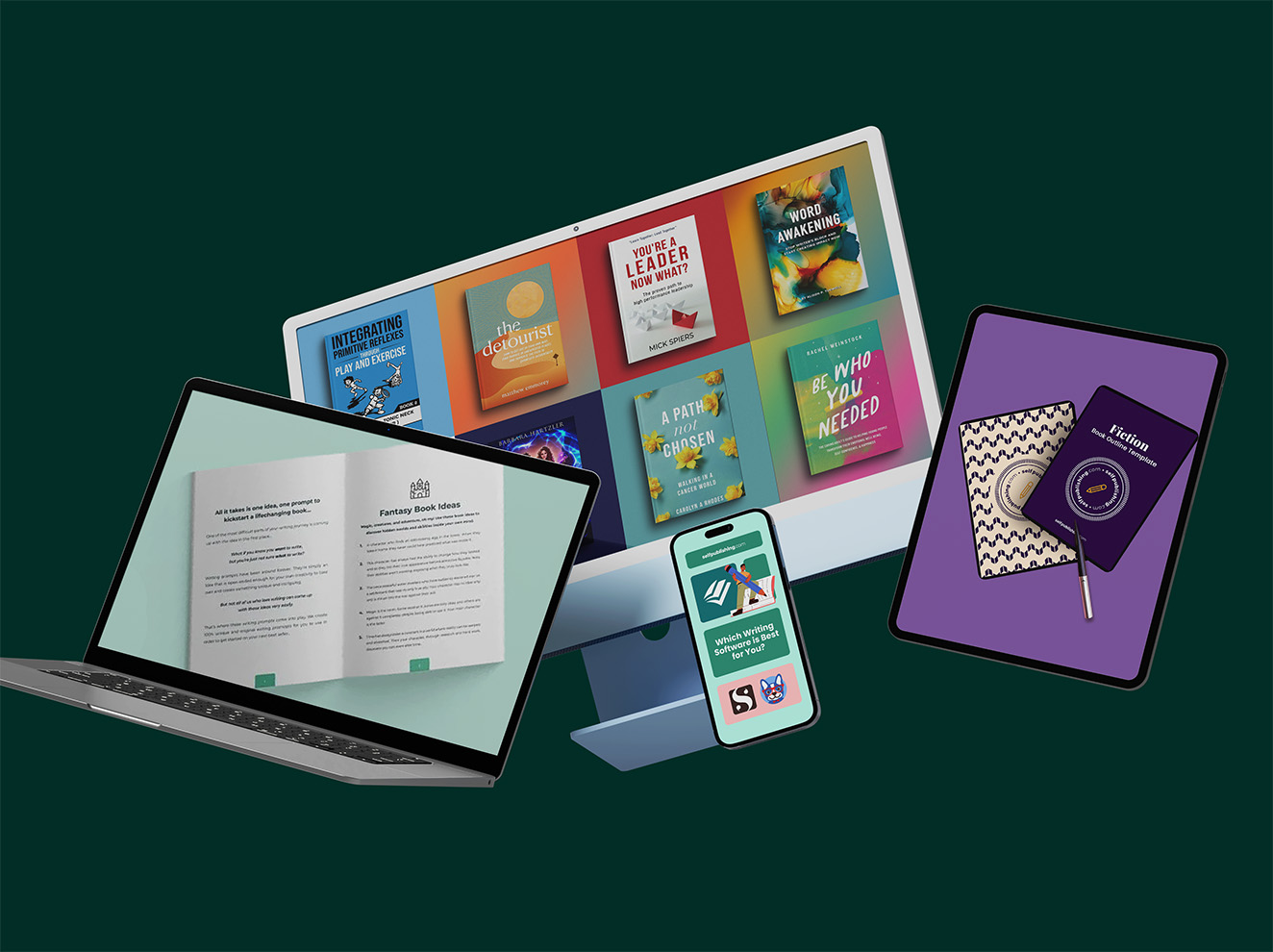Learning how to self-publish a book is one of the best things you can do for yourself as a writer. Self-publishing is taking the book world by storm…so what is self-publishing exactly?
If you’re a writer researching how to self-publish a book, you’re taking the right step by weighing all of your publishing options.
Self-publishing has become a household term for writers and authors all around the world, thanks to technology.
Being a writer in today’s digital age means you have more options than ever on how to become an author—and learning how to self-publish a book is among the best for those who want full creative control over their work.
What’s the big deal, you ask? Well, until recently, writers didn’t have much of an option outside of traditional publishing if they wanted to write a book.
The problem with traditional publishing is that it’s insanely competitive, and there are a lot of hoops to jump through to even have a chance at getting your book accepted by a traditional publishing house.
But now, the game is changing, and it’s never been easier for writers to learn how to self-publish a book.
In this comprehensive beginner’s guide, we’ll walk you through all the points you need to know about how to self-publish a book on your own. Of course, before you learn how to self-publish a book, let’s make sure you understand a bit about what self-publishing is.
What is self-publishing?
Self-publishing is the act of publishing media yourself without the use of a publishing house or company. Self-publishing is commonly referred to in the author and book publishing industry, but people can self-publish other works of art, such as music and visual art.
In terms of self-publishing a book, an author writes a book and completes the entire publishing process themselves, such as editing, designing, and formatting the book without the aid of a traditional publishing company.
An author who learns how to self-publish a book typically has complete creative control, higher book royalty rates, and full autonomy over the publishing process.
To self-publish, an author will publish a book at their own expense using a self-publishing platform, such as Amazon KDP, and typically maintains full rights to the book.
In short: When you learn how to self-publish a book, you will oversee the entire book writing and production process, from start to finish, at your own expense, and with full ownership of your book rights.
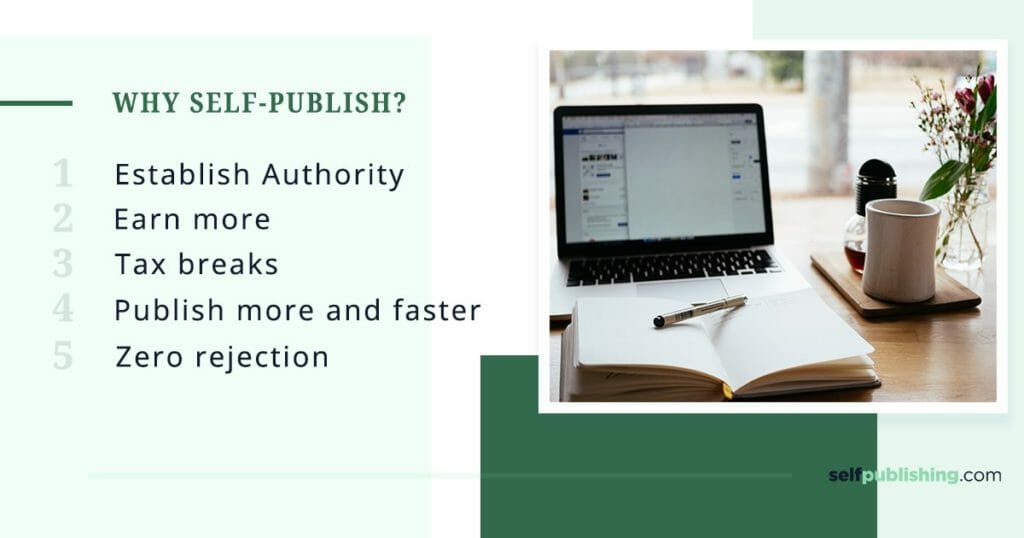
Here are the steps on how to self-publish a book:
- Write the book
- Self-edit the book
- Professionally edit the book
- Format the book
- Get illustrations (if you’re writing a children’s book)
- Get a book cover design
- Market the book
- Keep up with book maintenance
- Work with a self-publishing company if you so choose
You may feel a little overwhelmed looking at the steps for how to self-publish a book, but don’t worry! You don’t actually have to do all of those tasks yourself, but rather you will oversee and fund the process.
Because the entire book writing and production process is your responsibility when you learn how to self-publish a book, it’s important to make room in your publishing budget to hire professionals for the services you need, such as book editing and cover design.

The history of publishing
Now that you know what self-publishing is, it’s important to realize that authors weren’t always able to publish a book on their own.
Let’s embark on a quick journey through the history of publishing, which can help you understand how self-publishing is revolutionizing the modern author’s journey.
The printing press was created in 1440, which was a breakthrough technology in making books widely distributed. Thus, the traditional publishing industry as we know it came to be.
In the past and even still today, traditional publishers bought certain rights from the author in order to publish the work.
However, this took the power away from the storyteller, since the traditional publishers served as a “gatekeeper” – ultimately deciding which books would be widely shared, and which would not.
But along came the digital revolution. As with many aspects of our society, the internet revolutionized many industries, including publishing.
The rise of self-publishing
- Step 1.0: This phase began in the 1990s when eBooks began to be sold online. During this time, desktop publishing and print-on-demand technology came to be.
- Step 2.0: In 2007, Amazon launched the Kindle eReader and Apple released the iPhone. These two devices changed how people read books.
- Step 3.0: The industry is headed towards this third wave, which is characterized by direct sales from author to reader. We’ll cover more about this in a later section.
Self-publishing a book today
Today, writers can use powerful technology and the internet to learn how to self-publish a book and share their stories with a global readership.
Traditional publishers no longer control the storyteller’s narrative.
The only one that decides when to write and publish a story is the author themselves.
In fact, the $1 billion self-publishing market is evidence that it’s become the first choice for many authors.
With today’s growing industry, the road to being a self-published author has widened considerably.
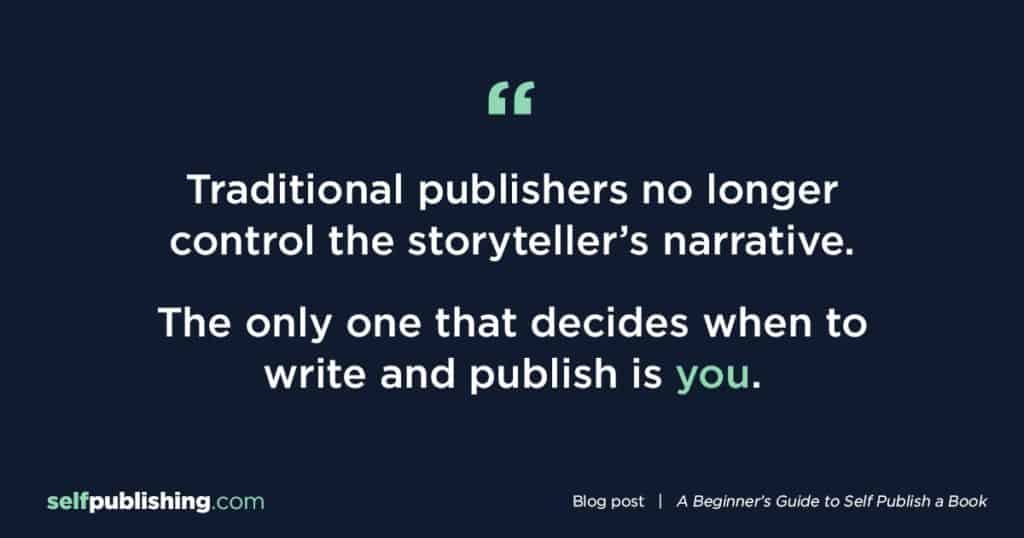
How to self-publish a book in 10 simple steps
Successfully learning how to self-publish a book on your own can be a time-consuming process, but it’s usually a lot quicker than the traditional publishing route.
While it does require time and effort, the good news is that the self-publishing method can be pretty clear-cut.
Here are the basic steps for how to self-publish a book:
1. Write a book
There’s no getting around it, if you want to learn how to self-publish a book, then you need to write one first! Of course, most writers think this is the fun part of the process. It’s also probably the step you are most accustomed to!
2. Choose a title for your book
If you want to publish your own book, then you absolutely need a title for it. Do some research to help yourself craft a catchy title that will sell (and that isn’t already taken). You might try a book title generator if you aren’t sure how to write book titles.
3. Hire a book editor
I don’t care how well you can edit other people’s work – we are all our own worst editors. We know exactly what we meant to say, so sometimes we skim over errors as if they weren’t even there. Hiring a professional book editor will save you a ton of trouble when learning how to self-publish a book.
4. Finalize your manuscript
It will probably take multiple pass-throughs with copy editors and line editors before you have the perfect manuscript. Don’t get yourself down during this process. It will be worth it to have your finished product in the end! Plus, you really do want to catch all those mistakes.
5. Hire a book cover designer
If you don’t have the skills to design one yourself, hire a book cover designer to create an eye-catching cover for your finished manuscript.
6. Decide where to self-publish your book
The next step in learning how to self-publish a book is to determine whether you would like to self-publish on Amazon KDP, Apples iBooks, or Kobo (more on these options later). This is also a good time to learn how to copyright a book if you haven’t already.
7. Format & publish your book on the platform
Next comes book formatting. You wouldn’t want to release a book with different size fonts or uneven margins. Nor would you want to use a font that gives your readers a headache. There is plenty of book formatting software that you can use before letting a professional formatter take a pass at your manuscript.
8. Plan and launch your book marketing campaign
There are so many fun book marketing ideas for before, during, and after book launch. Working with a self-publishing company can help you master these marketing techniques if they aren’t something you are accustomed to.
9. Price your book
Now it’s time to price your book. When learning how to self-publish a book, you should think of the price based on format, genre, and publishing goals. Take a look at some similar books and how they are priced. You may also want to offer a lower price for a limited time during pre-sale or launch to get some early reviews.
10. Continue to promote, market, and distribute your book
Book marketing never ends. If you want to keep making sales, you should keep promoting your book! When you run out of ideas, you can always write another book or create a special edition to market.
Remember, this is a condensed process of how to self-publish a book. You’ll want to educate yourself on the best process for each step to avoid making publishing mistakes.
And you’ll notice that many of the steps involved can be tailored to your specific situation.
For example, you can hire a book cover designer, or with the right tools and skills, you can make your own.
It’s important to dive deep into each step when you are working through the process of how to self-publish a book.
If you aren’t sure how to do a lot of the steps above, that’s okay! A self-publishing company can help you.
What are self-publishing companies?
A self-publishing company helps authors learn how to self-publish a book through the use of technology, services, education, and other means.
Self-publishing companies are mostly for-profit, and depending on the type of services offered, can assist authors and writers in using a publishing platform, helping with editing and other publication services, and assistance with navigating the publishing process and industry.
These are the main types of self-publishing companies:
- Self-publishing platform: This is the actual medium that you will publish your book on, which we’ll explain more about later.
- Author services: These are companies that provide author services such as editing, formatting, and designing. They’re like a one-stop shop for book publishing services, such as Reedsy. It can also include tools, like Publisher Rocket. Please do your research before using these types of services since many can lack transparency and quality.
- Self-publishing education: These are companies that teach authors how to self-publish a book. Since successful self-publishing can be tricky to navigate, these companies exist to provide authors with learning resources and mentorship. Self-Publishing School, Self-Publishing 101, and Your First 10K Readers all offer guidance if you want to do it yourself, but need a bit of hand-holding.
| Self-Publishing Company Type | Services Offered | Example |
| Self-Publishing Platform | Publishes & prints books | KDP, IngramSpark |
| Author Services | Editing, designing, formatting, etc. | Reedsy |
| Self-Publish Education (now with author services too) | Teach authors to self-publish | Self-Publishing School |
Traditional publishing vs self-publishing
It’s important to understand the differences between self-publishing vs traditional publishing as you determine how to navigate your own author career.
In order to see the big picture and decide whether you want to learn how to self-publish a book, taking an in-depth look at what exactly each publishing type entails is crucial.
What is traditional publishing?
In traditional publishing, you first need to land an agent, which can be a very competitive and time-consuming process, with no guarantees.
Once you have an agent, you need to find a publisher to accept your manuscript, which is also a very competitive and lengthy process (and again, no guarantees).
Then, the publisher will offer you a contract that essentially buys the rights to your book.
The publisher will take care of the publishing process from editing, formatting, and designing. You earn royalties based on how many books sell.
Here are the steps to traditionally publish a book:
- Secure an agent with a query letter.
- Secure a publisher with your manuscript.
- Agree to the publishing contract (if offered).
- Publisher buys the rights to your book and publishes your book at no upfront expense to you (the author).
Pros of traditional publishing
- Fewer upfront costs for the author. Since the publisher handles the production expenses, the author doesn’t worry about paying directly out-of-pocket so the cost to publish a book is less.
- Social prestige. Having publishing connections means your book will be easier to get into major bookstores. It can also be validating for some authors.
- Fewer responsibilities. You write the book, and let the publisher deal with the rest (ideally).
Cons of traditional publishing
- Extremely competitive. The chances of being traditionally published are very slim, and it’s very challenging to be accepted by a publisher.
- Less earnings. Royalty rates are often significantly less for authors in traditional publishing.
- A ton of rejection. To even be considered by an agent or publisher nowadays, writers often must have a social following or fan base.
- Not much marketing support. The publishers handle the actual book publishing, but marketing is often left up to the author.
- Less creative control. Authors typically don’t have any say-so in the final product. So, your book may be edited and designed without your input.
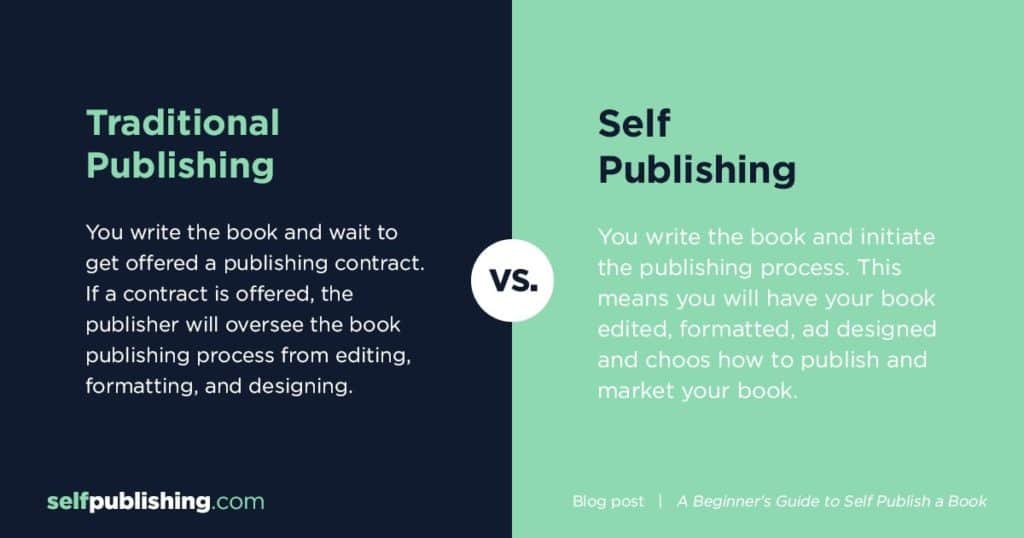
Pros and cons of self-publishing
To recap self-publishing, it goes something like this: You learn how to write a book, you write it, and then have the book edited, formatted, and designed.
Then, you have a printer or publishing platform publish your book, while you market the book and do book maintenance.
When you learn how to self-publish a book, it can be rewarding for a number of reasons. In fact, many self-published authors chose this route simply because of its many benefits.
However, there are also some cons to publishing a book on your own, which we highlight in this section. It’s important to be mindful of the possible advantages and disadvantages as you decide whether or not to learn how to self-publish a book.
| Pros to self-publishing | Cons to self-publishing |
| No gatekeeper | Less support |
| Your own timeline | No one is pushing you |
| Complete creative control | More upfront costs |
| Greater earning potential | Stigma |
| Higher royalty rates | More responsibilities |
Pros of self-publishing
- No gatekeeper. There isn’t anyone standing in your way of getting your book published. The only person that can stop you from sharing your book with the world is YOU!
- Your own timeline. Authors who learn how to self-publish a book can get their book to market quicker than with the traditional publishing process.
- Complete creative control. You have the final say in how you want your book to be edited, formatted, and designed.
- Opportunity for greater earning potential. Royalty rates on publishing platforms like Amazon are significantly higher than traditional publishing rates.
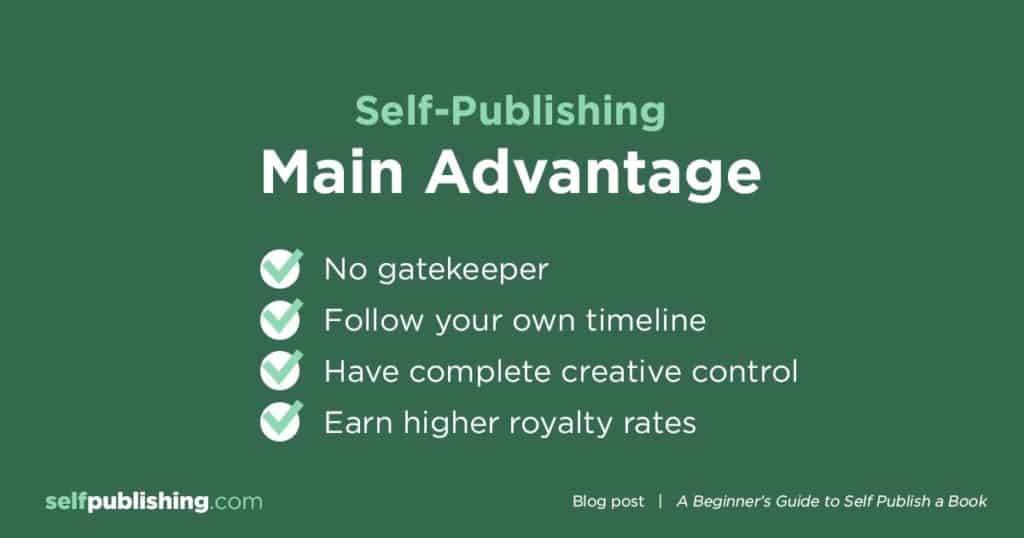
For some authors, learning how to self-publish a book can have its downsides. Be sure to consider your own needs and preferences as you weigh the possible cons.
Cons of self-publishing
- Less support. It’s all in your hands, which can be very scary for some authors. Learning how to self-publish a book also be lonely without a supportive community.
- No one is pushing you. It’s up to you to set your own deadlines, make realistic writing goals, and get the ball rolling on your published book.
- More upfront costs. When learning how to self-publish a book, you may have to hire professionals for publishing services like editing and designing.
- Some stigma. Because traditional publishing has been the standard for so long, self-published authors are sometimes considered the underdog. But the tide is changing. We’re seeing waves of successful authors who were traditionally published switch over to self-publishing, like Michael Hyatt, Ruth Soukup, and more. They’re realizing they can invest in professional services to produce high-quality books and they can leverage their own platforms to sell more books at a higher royalty rate.
If you’re curious to know whether traditional publishing or self-publishing has greater earning potential, try using our Book Royalties Calculator! It may help you determine if you want to learn how to self-publish a book.
Book Royalties Calculator
1. My book will be published by a...
2. My book will be an:
3. My royalty rate will be:
*Please note that this royalty rate is based on the market averages for paperback books. Actual royalty rates for traditional and indie publishing can vary by author depending on several factors.
4. My book’s retail price:
5. The # of books sold:
Your Results
Your Profit per Book Sold
For books sold, you earn:
For 1,000 books sold, you earn:
For 10,000 books sold, you earn:
Royalties Comparisons for 10,000 books sold
How much does it cost to self-publish a book?
Since the author oversees all aspects of the process, the costs to self-publish a book will vary. You can self-publish a book for as little, or as much money as you can afford.
On average, the costs to self-publish a quality book will be about $1,500 – $5,000 depending on the professional services you use during the publishing process.
Many platforms to self-publish are actually free, but where the costs accrue is during the editing, illustrating, designing, and marketing phases.
Several factors affect how much it costs to self-publish and it really depends on each author’s needs.
This means that you can determine the budget when learning how to self-publish a book. Just remember – don’t cut too many corners as this could negatively affect your book’s quality!
The actual cost to publish a book yourself is free on self-publishing platforms like Amazon Kindle Direct Publishing (KDP).
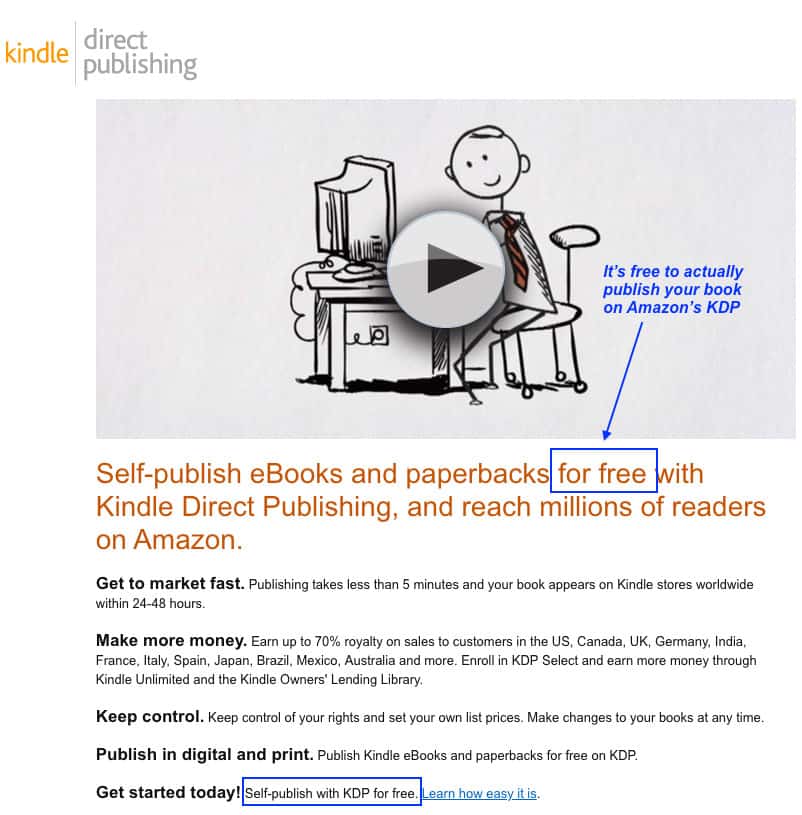
But at the minimum, authors need to hire a professional editor and cover designer.
For example, the table below covers the average cost of common professional services used to self-publish a book.
| Professional Publishing Service | Average Cost |
| Book Editing | $300 to $5000 (depending on word count) |
| Book Formatting | $50 to $500 |
| Book Interior Design | $100 to $1,000 |
| Cover Design | $250 to $1,000 |
| Marketing Promotion | $0 to $1,000 |
Again, it all falls back on you as the author, and what your motive is for publishing your book.
Are you looking to build a career? Then you’ll want to invest in hiring experienced professionals that can provide the best quality, this may include investing in a self-publishing company, like Self-Publishing School, to help you do it right.
Other services you may need to budget for as you consider how to self-publish a book are marketing tools and promotional sites to promote your book.
You can use this Book Profit Calculator to determine how much you can make off your book based on your book price and royalty fees.
Where to self-publish your book
Because there are many platforms to publish your book available, it can be confusing to decide which self-publishing company to actually choose.
However, there are some self-publishing platforms that offer services that you may or not may need. Not every platform is the same, so once you have a solid understanding of the type of services you seek from your publishing company, the easier it will be to narrow down the options and decide where to publish your book.
First off, you’ll need to know the two different types of platforms: retailers and aggregators, which have some overlap in services they offer, but there are some fundamental differences as well, which we’ll cover below.
Tips on where to self-publish your book
- Decide between a retailer or aggregator company
- Determine your publishing budget
- Choose the type of book you want to publish
- Select the best publishing platform based on your region
- Figure out which markets you want to reach
- Decide your end goal for publishing
- Research company reviews
- Determine your technical skills and if you will need more assistance
Self-publishing retailers
Book retailers are platforms that host and sell your book directly. With a retailer, you will upload your book and it will sell directly to readers on the platform. Examples are Amazon’s KDP, Apple’s iBooks, and Kobo.
- Amazon’s KDP has the most retail power. It dominates the self-publishing market with over 80% of the eBook market. When considering where to self-publish, KDP is a must. You will get paid 35% or 70% royalty rates, depending on which you choose.
- Apple’s iBooks is steadily gaining more traction for self-publishing. It’s reported to have 10% of the market. If you use a Mac, this could be an option on where to self-publish. You will be paid 70% royalty rates.
- Kobo holds a small but powerful percentage of the self-publishing sphere. But it has access to an international market, so don’t pass it up! To have your book available in Canada and over 190 countries, consider Kobo when figuring out where to publish. Royalty rates depend on the price of your book.
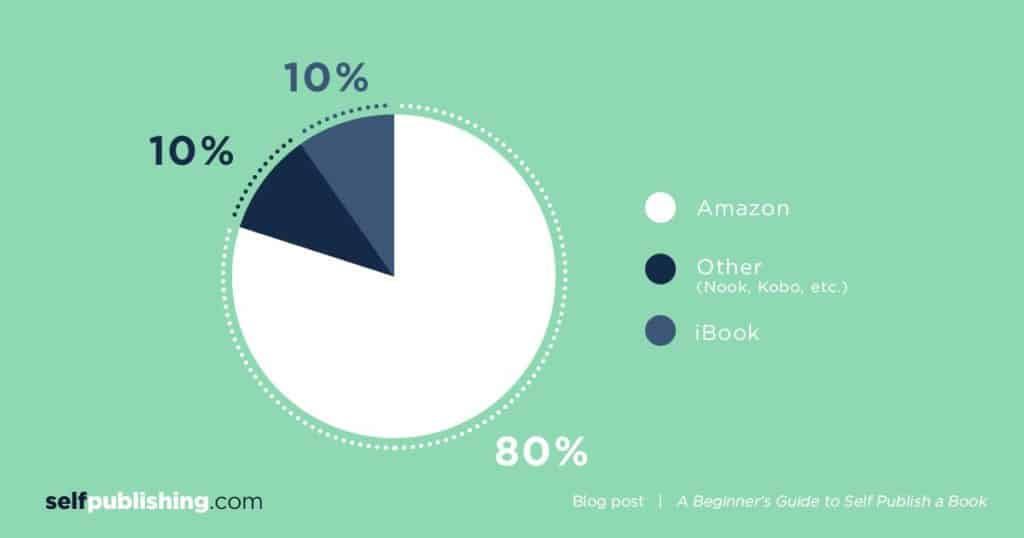
Aggregators
Book aggregators are mediums that you submit your book to, and they send it to retailers and libraries all at once. While it may be more convenient so you don’t have to figure out where to self-publish, the cost to use these companies may be higher.
These are examples of self-publishing book aggregators:
Decide where to self-publish your book after assessing which markets you want to reach, as well as your budget and needs. Some authors even use a combination of retailers and aggregators when learning how to self-publish a book.
Self-publishing industry trends in 2024 and beyond
All this talk about the past and the present, but what about the future?
It’s safe to say that self-publishing is not a fad – it’s here to stay as long as the internet is around, and will only continue to evolve.
In fact, the industry is now entering Self-Publishing 3.0. This phase will be direct sales from author to reader by way of subscription models, crowdsourced funding, and other income streams.
Self-publishing trends focus on the increased opportunities for authors to use technology and the internet to build sustainable businesses and writing careers.
Some forecasted industry trends for self-publishing are:
- Direct author to reader without any middleman
- The rise of the “authorpreneur” and indie authors
- Blockchain technology
- Decline of major publishers
- Expanded eBook subscriptions
- Less stigma
- Voice marketing as a new avenue for authors
- Increase in self-published books in the retail world
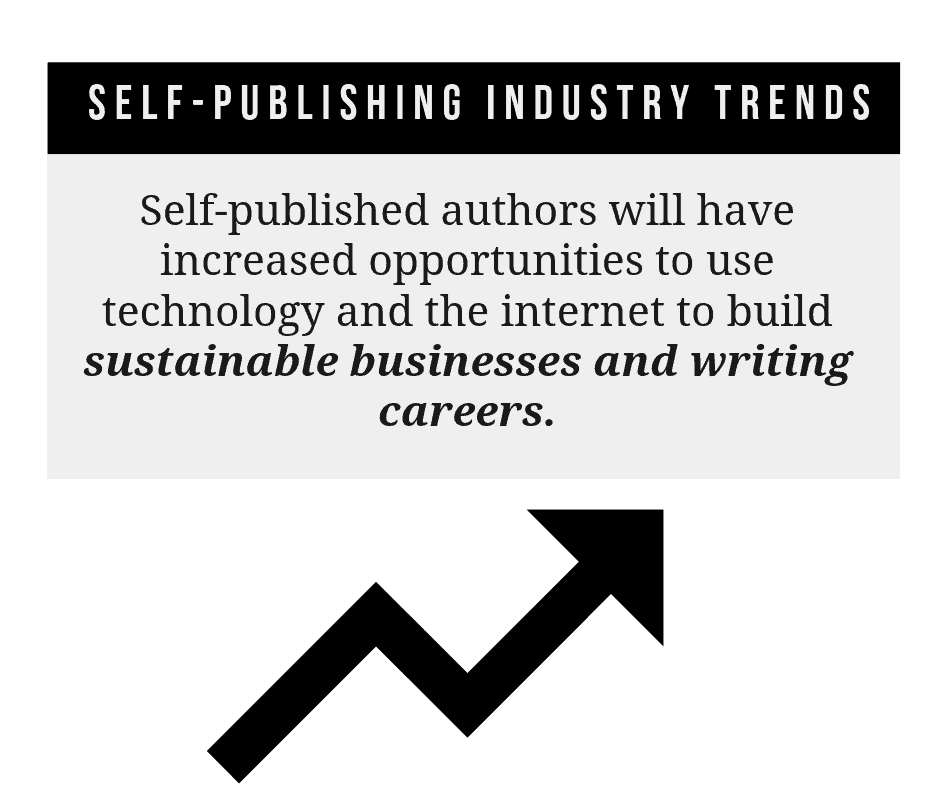
A clear best choice for aspiring authors
Learning how to self-publish a book allows you to publish your writing and share your stories with the world.
If you can make time for writing, execute a publishing strategy, and invest in the quality of your book, you can create a legacy from your book.
Whether you want to write a nonfiction book, write a novel, or create a children’s picture book, the options for publishing a book on your own are virtually limitless.
In fact, you don’t even have to pass through the traditional publishing gatekeeper to become an author.
Today, writers and storytellers are more empowered than they ever have been in history.




















